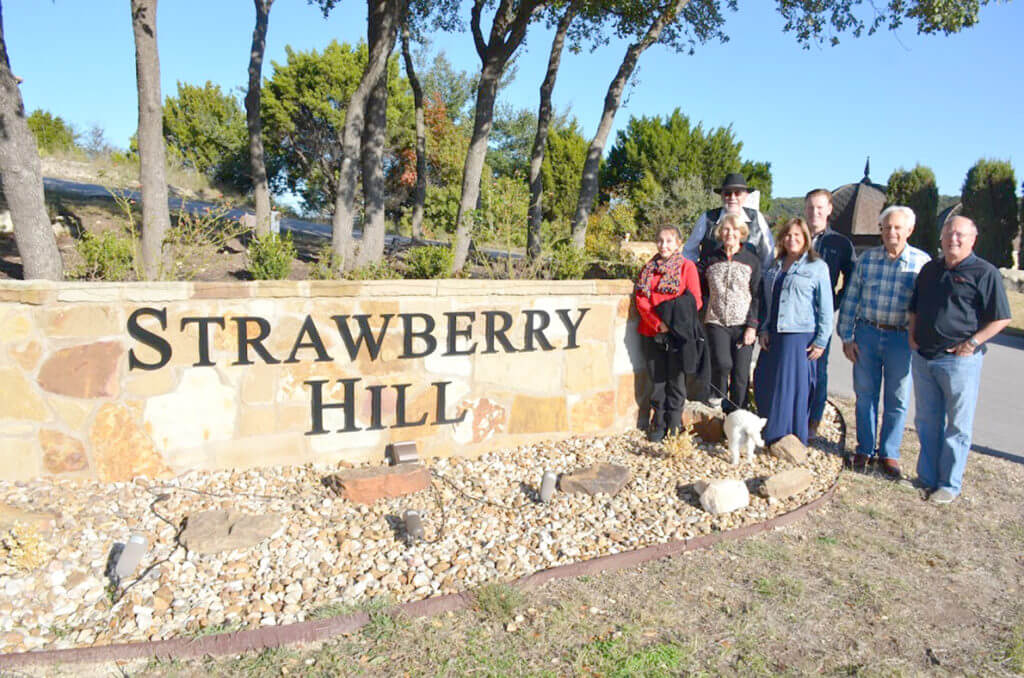By K. Q. THOMAS, Four Points News

The Strawberry Hill neighborhood has emerged over the last several decades to what it today — a close-knit and caring community where many residents have expansive Lake Travis views.
Located west of Steiner Ranch and adjacent to St. Luke’s on the Lake Episcopal Church, Strawberry Hill has roughly four dozen lots with 26 homes and some under construction now. The community erected a sign in January 2017 at its entrance off of RM 620.
Strawberry Hill began as an area of summer homes, with the hill, of course, covered with wild strawberries. In the 1970s, as Austin grew, and 20-minute commutes to downtown Austin didn’t seem as daunting, Strawberry Hill became an attractive area for those looking for a year-round home.
Carol Butler, and her husband John, bought their Cedar Street home in 1997 from one of the original summer dwellers.
“We had wild strawberries growing in our yard for a few years after we bought the house,” she said.
Strawberry Hill Homeowners Association secretary Carla George was attracted to the views.
“The one thing that drew us to move to Strawberry Hill was the amazing view of the main basin of Lake Travis,” George said. The day she and her husband David discovered the community is one they will not forget.
“We were on our way to Lakeway with a realtor. We happened to see a ‘For Sale’ sign from 620,” she said. “When we stepped onto the lot and saw the view, we knew this was where we wanted to build our forever home.”
The Strawberry Hill HOA, informally formed in the 1970s. Along with the upkeep of typical common areas, the HOA is responsible for the neighborhood’s roads and their maintenance.
This is fast becoming an issue for the neighborhood as traffic increases and cars use neighborhood streets as alternative routes. Hundreds of cars, for example, use the neighborhood’s private road as a shortcut to avoid traffic between Marshall Ford Road and Cedar Street, despite numerous stop signs and speed bumps. Travis County, which as yet offers no funding for road maintenance, may have to offer some financial help.
“When 620 is backed up, traffic here can be a problem,” George said. “It’s not just an annoyance. It puts a burden on our roads and on our HOA resources.”
“We are working diligently to fully privatize our roads and add a security gate to prevent drive-through traffic,” she added.
The HOA also had to lobby the county for larger water lines after the Steiner Ranch fire in September 2011.
Sherry Reynolds and husband, Kevin, bought their house on Linden Street in 2009.
“We usually have very little traffic on our street,” Reynolds said. But during the fire, Steiner Ranch residents were all over her area, looking down the hill to find their property and assess the conditions. Twenty three Steiner Ranch homes were destroyed by that fire, which was caused by faulty electric lines.
The fire thankfully never made it to Strawberry Hill, but “if the wind had been right, the fire could have easily jumped 620,” Reynolds said. Neighborhood utilities couldn’t handle an emergency of that magnitude, she said. “So we petitioned to have the water mains increased in size, and new hydrants. The board worked really hard on that. And we feel much safer.”
But the Strawberry Hill HOA isn’t all about issues. Strawberry Hill has several social events throughout the year. All of the HOA meetings which are always followed by a wine and cheese social. The neighborhood has get togethers for National Night Out, and have additional social events in the summer and winter.
“Strawberry Hill is an eclectic neighborhood with great neighbors,” George said. “Being a small community and because of our regular social events, everyone knows everyone. Even though our geography isn’t conducive to seeing each other on a daily basis, we still make efforts to get together frequently and communicate via email and everyone looks out for one another.”
Reynolds agreed. “This community is exactly the kind of community we were hoping for. Everybody looks out for everybody.”

